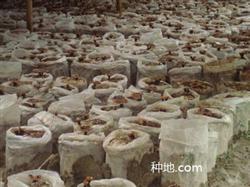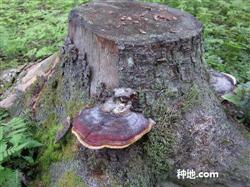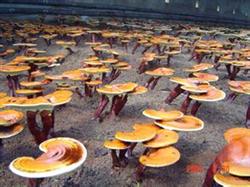Is there any new planting technology of Ganoderma lucidum?

Is there any updated Ganoderma lucidum planting technology? You can see and learn the following several planting methods of Ganoderma lucidum for reference. Ganoderma lucidum is a traditional fungal medicine in China. It has been used as a traditional Chinese medicine and longevity tonic for thousands of years, and the domestic market has great potential. There are broad prospects for the development of Ganoderma lucidum industry. This paper introduces the cultivation techniques of short-segment wood of Ganoderma lucidum: first, the good tree species of cultivating raw and auxiliary materials for cultivating Ganoderma lucidum are Fagaceae, Hamamelidaceae, Betulaceae and so on. In general, it is appropriate to choose thick bark, not easy to detach, hard material, less heartwood, developed pulp rays, rich ducts, and 8cm~13cm DBH. Cut down in the early stages of falling leaves? No more than stinging. Second, the choice of cultivation season Ganoderma lucidum belongs to high temperature fruiting fungi. 10 ℃ ~ 12 ℃ is the production period of the cultivation tube. After inoculation, it takes 60-75 days for short wood to reach physiological maturity. Third, the setting of the cultivation place outdoor cultivation is best to choose the place with loose soil, open terrain, water and convenient transportation as the cultivation field. The cultivation field needs to build a shade shed with 2m~2.2m height and width of 4m. The shed is divided into two sides, the width of the border is 1.5m, and the border leaves a drainage ditch. If conditions permit, the roof can be covered with a black sunshade net, with a shading rate of 65%, so that a strong scattered light is formed in the shed, and the service life is more than 3 years. 4. The low-pressure polyethylene cylinder with opposite folded diameter 15~24cm × 55cm × 0.02cm is selected for packing. Three kinds of plastic cylinders are mostly selected in production in order to be suitable for the cultivation and use of short-section wood with different caliber. Put the truncated short piece of wood into the plastic barrel, match the two ends, bend, tie the folding head with a small rope and tie it tightly. Bags with plastic cylinders larger than 2~3cm in diameter, one bag for 30cm long wood and one bag for 15cm long wood, or several segments can be packed into a bundle into a large bag for sterilization. 5. Sterilization was immediately followed by routine atmospheric pressure sterilization of 97 ℃ ~ 103 ℃ for 10 to 12 hours. Sixth, the varieties with marketable, good quality and high yield are selected as production strains. At present, the strains used are g801, g802, G6, G8 and so on. The production method is the same as that of wood saprophytic fungi, and it is better to use sawdust cottonseed shell. During the inoculation, the water content of the strain was slightly better, and the cooling short wood plastic tube was selected in advance and fumigated with an aerosol disinfection box. After 30 minutes, the bacterial skin on the surface of the plastic bag was discarded and the double-head inoculation method was used. With the cooperation of the two, one untied the plastic binding rope, and the other sprinkled a strain the size of peanut kernels near the fire mouth of alcohol, and immediately sealed and fastened it. The other end is inoculated in the same way, and so on, and then layered on the shelf. In the process of inoculation, the time of opening the bag should be shortened as much as possible, the amount of inoculation should be increased, the cross section should be sealed, and the pollution should be reduced, so that the hyphae can spread rapidly along the wood rays of short wood. 7. The temperature is relatively low in winter, so it should be artificially heated to more than 20 ℃, and the rope can be loosened slightly after 15 days of culture. The cultivation of short-section wood is full for 45-55 days, and it will take another 15-20 days to enter the physiological mature stage. Eighth, put the physiologically mature short pieces of wood horizontally into the border surface, and the transverse spacing of the segments is 3cm. The effect of this horizontal burying method is better than that of vertical Ganoderma lucidum. Finally, the soil is covered comprehensively, and the thickness is 2~3cm. Drenched heavily for two days in a row. Every 200cm, a short curved arch is erected with a piece of bamboo, 15cm off the ground, covered with a film, and slightly opened at both ends. The soil moisture of the buried soil is 20%-22%, and the relative humidity of the air is about 90%. 9. Ganoderma lucidum management fruit body development temperature is 22 ℃ ~ 35 ℃, enter the bed to keep the border surface moist, with fingers pinching soil particles with cracks as the degree, would rather be dry. Young Ganoderma lucidum appeared one after another in the middle and late May, and the water management was dominated by the alternation of dry and wet. It is necessary to close the film at both ends of the shed on the border at night in order to humidify and reopen it during the day to prevent the border surface from being too high in carbon dioxide, more than 0.1%, resulting in "deer horn Zhi", undifferentiated bacteria cover, only long handle. Ventilation is the key to ensure the normal development of Ganoderma lucidum cover. After June, the film at the top of the arch shed should always be covered and opened on both sides to prevent the high humidity of the soil and wood caused by rain. In the middle and last ten days of June, thickening shade is often used to ensure high air relative humidity on the border surface. When the surface shows a paint-like luster, spores can be collected or fruiting bodies can be collected. Harvest and drying can be harvested when the cap is no longer enlarged, the white edge disappears, the cover edge is thickened, the color of the cover is the same, and the spores are scattered. The fruiting body after harvest should be cut and discarded the fungal stalk with sediment, baked at 40 ℃ ~ 60 ℃ until the water content is less than 12%, and finally sealed and stored in a plastic bag. Increase the production of mushrooms? Artificial stimulation? In the fruiting body formation stage of Pleurotus ostreatus, the temperature difference stimulation of 7 ℃ ~ 12 ℃ per day can promote the mushroom to produce early. The method is to cover the film to keep warm in the daytime, uncover the film and open the bed in the morning and evening in sunny days, increase the temperature difference by cooling, and combine with high temperature watering to induce mushroom emergence. The high temperature stimulation method first dries the bacterial bed (or bacterial bag) for 1 or 2 days, and then carries on the continuous re-spraying water, so that there is a large amount of stagnant water on the bacterial surface, so that the bacterial bed (or bacterial mass) is slowly absorbed, spraying water 2 times a day for 2 days. Finally, use cotton cloth to absorb the stagnant water on the bacterial surface, cover with plastic film to keep warm, and bud can appear after a few days. After the culture medium is full of mycelium, the shock stimulation method uses elastic wood strips to squeeze, beat and vibrate the culture surface to accelerate the growth of mycelium and the rapid differentiation of fruiting body, which can generally increase the yield by about 15%. But the force is required to be uniform so as not to destroy the material surface. The pressure stimulation method covers the culture surface with sterilized old newspapers, sacks and fine soil, which can promote the rapid growth of mycelium under the stimulation of pressure. When Pleurotus ostreatus is planted in the mushroom house induced by light, a certain amount of scattered light is needed when the fruiting body is formed. Pleurotus ostreatus should be infected in the dark after sowing, and the mushroom can be induced by exposure after the hyphae are ready. When there is a lack of light, electric lights can be used instead, and it also has a good stimulating effect. Spraying 0.5~1ppm triacontanol in the bud stage with hormone stimulation could increase the yield by 10% to 15%. In the mushroom bud stage, young mushroom stage and cap expansion stage, the ethylene of 500ppm can be sprayed continuously for 3 times, each time 50ml per square meter, which can increase the yield by 20%. In the method of compound agent stimulation, the compound liquid was prepared by adding regulator (b9) 5g, magnesium sulfate 20g, boric acid 5g, zinc sulfate 10g, vitamin b1250g, urea 50g, and 50kg to water. Spraying on the culture material during the formation of mushroom buds can promote the formation and hypertrophy of fruiting bodies. Alcohol stimulation method ethanol 2%, potassium dihydrogen phosphate 0.1% plus vitamin c 0.02%, spraying in the mushroom bud stage can increase the yield by more than 15%, but with caution in muggy weather. MSG stimulation monosodium glutamate? Sodium glutamate 0.1%, glucose 1% plus vitamin b1100 tablets to water, sprayed about 7 days after the first stage of mushroom harvest, 0.5~1kg per square meter, a total of 3 times 4 times, can increase the yield by 15% to 20%. The plant ash stimulation method takes 5% of the plant ash soaking clarification solution to spray, which can promote the mycelium growth, produce strong mushrooms, and prevent the mycelium from becoming red. Generally, spraying after each batch of mushrooms is harvested can increase the yield by about 20%. See more planting techniques of Ganoderma lucidum
- Prev

There are common wild Ganoderma lucidum.
Common are those wild Ganoderma lucidum, ask for introduction, wild Ganoderma lucidum because of its different varieties, pharmacological effects have their similarities, but also have personality. The personalities of different common wild Ganoderma lucidum varieties are introduced as follows: Ganoderma lucidum document name: Ganoderma lucidum, Ganoderma lucidum and so on. Morphological features: son.
- Next

How can ganoderma lucidum be cultivated for high yield?
How can ganoderma lucidum be cultivated for high yield? Please elaborate on Ganoderma lucidum also known as Ganoderma lucidum grass, fairy grass. It is a rare large-scale medicinal fungus, its fruiting bodies and spores for medicinal purposes, with nourishing fitness, longevity effect, in the clinical treatment of neurasthenia, chronic bronchitis, gastropathy, liver disease, high...
Related
- Fuxing push coffee new agricultural production and marketing class: lack of small-scale processing plants
- Jujube rice field leisure farm deep ploughing Yilan for five years to create a space for organic food and play
- Nongyu Farm-A trial of organic papaya for brave women with advanced technology
- Four points for attention in the prevention and control of diseases and insect pests of edible fungi
- How to add nutrient solution to Edible Fungi
- Is there any good way to control edible fungus mites?
- Open Inoculation Technology of Edible Fungi
- Is there any clever way to use fertilizer for edible fungus in winter?
- What agents are used to kill the pathogens of edible fungi in the mushroom shed?
- Rapid drying of Edible Fungi

